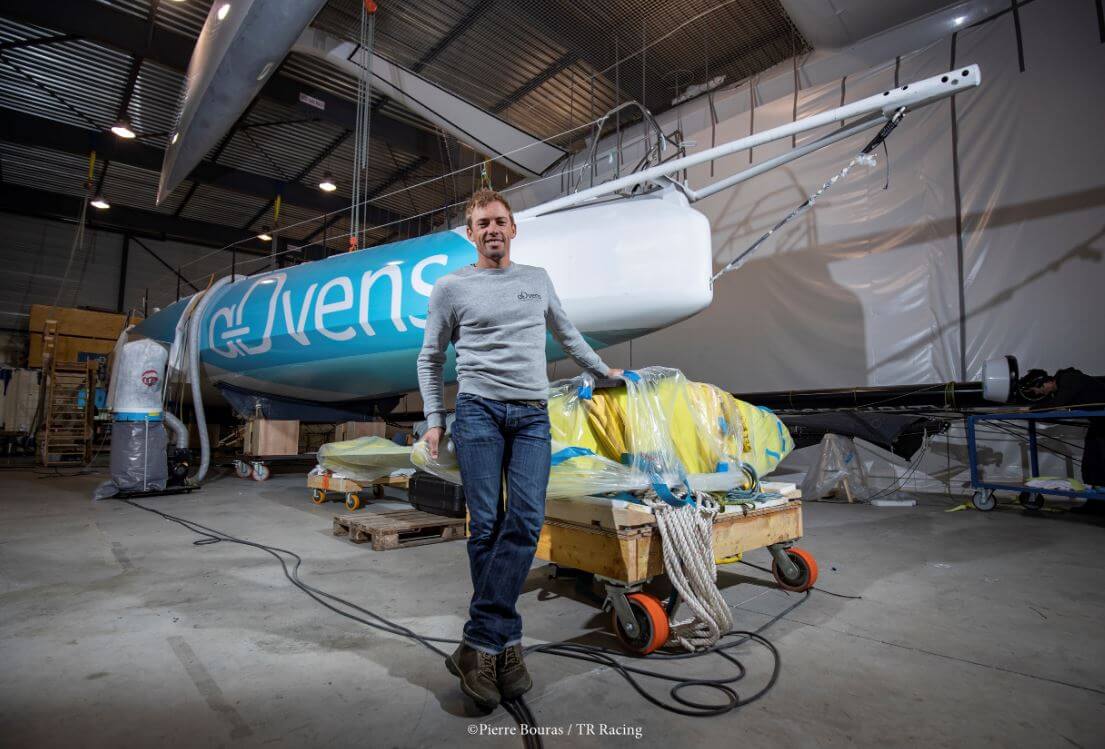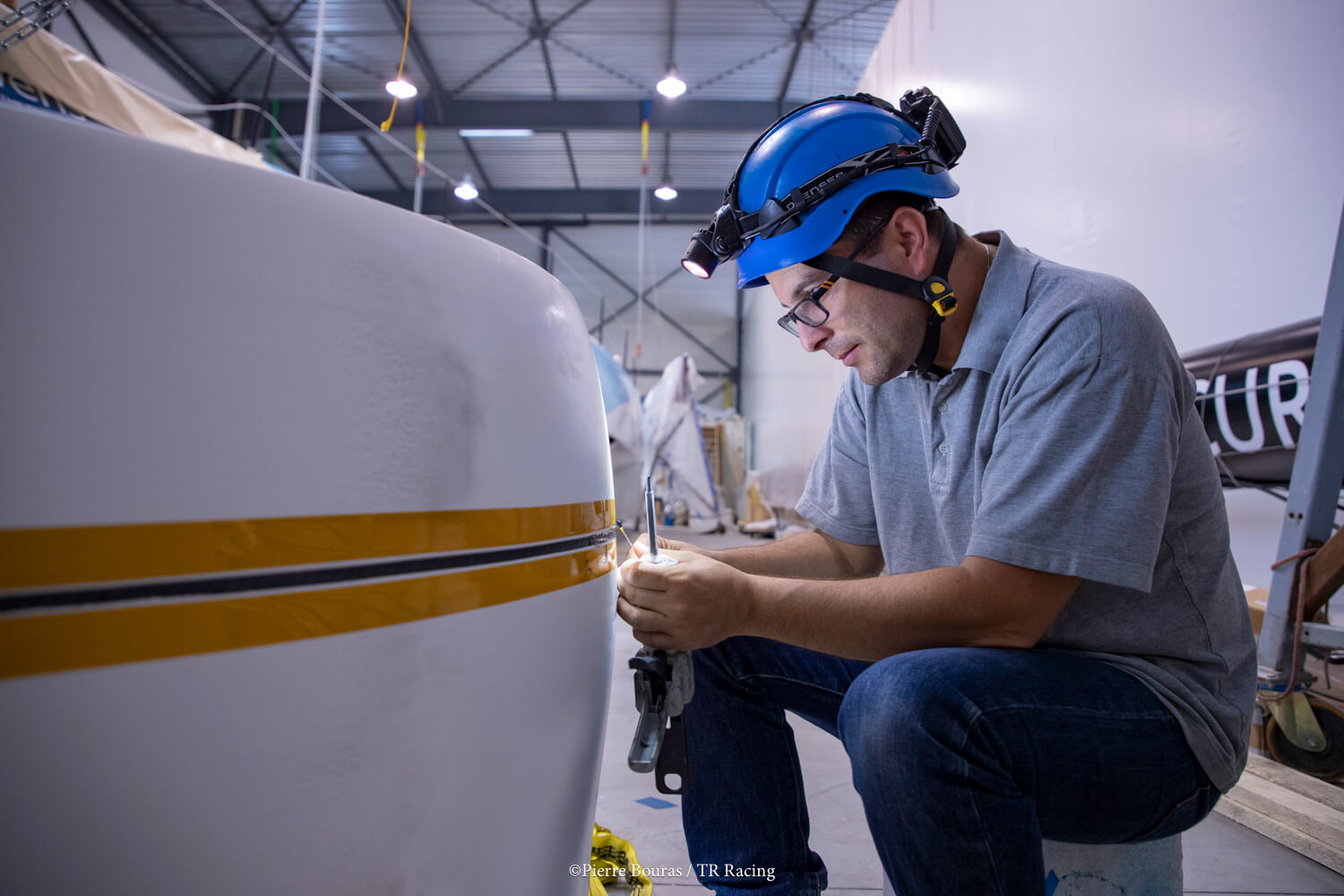Highly aware of the latest technological advances in the field of measurement, this year’s IMOCA Thomas Ruyant Racing teams have chosen a fibre optic strain gauge, which is more robust than conventional gauges.
With its reputation for reliability and competence with complex equipment, the IMOCA designer once again contacted HBK to help with the project.
HBK's South-West Europe engineering department, managed by Carola Corazza, worked with Laurent Bourgues to define the characteristics of the gauges, as well as the method of installation on the foil. "My department usually works as close as possible to the customer's site. In this case however, we made a small exception, at the customer's request. Thomas Ruyant Racing is based in Lorient, but the meeting took place in Italy, because it was important to work closely with the designer of the boat's components - Persico Marine – who is based in Italy," explains Carola.
An array of strain measuring FBGs in bare fiber, the FS70FBG, was chosen to carry out the deformation measurements and - for each foil - four measurement points were determined. "The discussions with the customer enabled us to understand all his needs and to propose solutions. The same fibre could be used to carry out the temperature measurements. We therefore agreed to customize it and integrate a thermal sensor into the array," explains Carola.
According to the customer's specifications, all these measurement points (Bragg gratings) are determined and precisely placed along the fibre. This fibre is coupled to the FS22 DI dynamic optical measurement system (also known as an optical interrogator), which converts the optical measurements into digital data that can be used by conventional acquisition systems. The distance between the farthest measurement point and the optical interrogator is five metres - a relatively short distance in comparison to some applications that require fibres with a length of more than 30 metres.
HBK Engineering Service Team Gets Onboard IMOCA’s Advens Cybersecurity Project
During the last Vendée Globe race, HBK was involved in the Advens for Cybersecurity project, which involved developing and installing optical strain gages on the foils of a boat.
These foils are special ‘wings’ placed under the ship’s hull, composed of a shaft (the longest, typically straight part that goes in and out of the hull), a bearing plane (usually curved) and a tip (a straight, vertical part). As the boat gains speed, the hull rests on the lower part of the foils, which raises it up, so it has less resistance to water and increases speed. The foils are most effective when sailing on reaching (side wind) and can only be used when sailing conditions are relatively calm. Depending on these different factors - and to further optimise the boat's performance – there’s also a mechanism which allows the foils to be retracted into the hull.
The use of foils in offshore racing is recent; they were used for the first time in the 2016 Vendée Globe (the race takes place every four years). Their effectiveness was quickly felt - with the first four boats to arrive at the finish, having been equipped with them - but the technique showed some weaknesses. Since then, the designers have worked to improve both performance and reliability.
Problem
The Vendée Globe – a single-handed, non-stop yacht race around the world, lasting for a period of several months – has garnered attention far beyond the world of sailing, due to the courageous skippers, who will be tackling the gruelling, three-month course without any assistance.
During this time, they’ll face extreme weather conditions, rough seas (particularly in the Pacific and Antarctic oceans) and the constant dangers associated with solo sailing. As such, the Vendée Globe is not just an adventure, but an undertaking that requires robust, high-performance boats, that can cope with being constantly pushed to their limits - and sometimes beyond.
Solution
The yachts lining up in this competition are packed with high-tech equipment, including sensors which are vital for monitoring a boat’s performance. Test and measurement expert, HBK, which has a reputation for manufacturing high-end sensors and acquisition systems that can withstand extreme environmental conditions, was approached to assist with equipping the vessels using optical strain gauges.
Results
This project was quickly finalised, enabling the boat to launch in September 2019 - eight weeks before the start of the Transat Jacques Vabre. After a few tests, it was lined up for the race. In spite of a failure - linked to the automatic pilot jacks - shortly after the start, which forced a four hour stopover in Cherbourg, Advens for Cybersecurity proved to be very efficient and finished in an admirable fifth place. This comeback is due to strong averages; in one day alone, the yacht covered 521 miles in 24 hours at an average speed of 22.30 knots.
The International Monohull Open Class Association (IMOCA)
The International Monohull Open Class Association (IMOCA) was the company responsible for designing and preparing the IMOCA Advens for Cybersecurity for the last Vendée Globe, with Thomas Ruyant as skipper.
Its Technical Director, Laurent Bourgues says: "Foils have become an essential element of performance. Today, it is no exaggeration to say that the boat is being built around the foils, rather than the other way around.”
"As for the foils, we are still in a learning phase, as they are constantly evolving, particularly in their shape and dimensions. The validation of the technical choices, design data and behaviour when pushed to their limits, is conducted whilst at sea," continues Laurent.
Due to a lack of time - and also money (a single foil costs approximately 150,000 euros), it is not possible to develop and test prototypes in the laboratory. "For these reasons, we have decided to instrument the foils and record the measurement data. This helps the skipper ensure the boat does not go beyond its limits and we can perform an analysis afterwards, correlating results with other data, such as wind, sea conditions, boat speed, etc," adds Laurent.
"The foils obviously played an important role in achieving this performance. Thanks to the sensors and the acquisition system, the skipper was able to use them optimally, without exceeding the limits," explains Laurent Bourgues.
The Choice of the Optical Fibre

A Race Against Time...


These technical choices were defined in the first quarter of 2019. At that time, the race against time was already underway for IMOCA Thomas Ruyant Racing, who wanted to line up their boat for the double-handed Transat Jacques Vabre, scheules to sail from Le Havre to Salvador de Baia in Brazil, on 27th October. So - for practical reasons and to save time - the foils were completed in Lorient, rather than Milan, as initially planned. HBK's engineering teams have expertise throughout Europe, so adapted easily to this change of plan. As a result, the installation of the optical gauges was carried out by HBK’s Field Service Engineer, Nicolas Visoianu who is based in the companys’ French office.
The foils - comprised of a technical stack featuring several layers of carbon fibers - have been specially designed to integrate with the optical fiber and the outer part contains a groove. Inserting the fiber into this groove is a meticulous job, as explained by explains Nicolas: "As these are relatively heavy and difficult to handle, the foil was fixed in a position that would allow me to work in good conditions. To obtain optimal performance, it is very important to position the fibre precisely and to pay great attention to the bonding. Mistakes made here cannot be corrected! In this area, HBK has acquired expertise that sets it apart from its competitors. In the end, one must be able to supply µm/m, guaranteed with acceptable uncertainty. This is a level of expertise that is difficult to achieve.”
The X120 glue used is also an illustration of the expertise in this field – it has been specially designed for mounting this type of gauge. It fills the groove until it is flush with the surface, allowing a protective layer to be added, making it resistant to seawater.
After this successful first race, an assessment was necessary, so the recorded data was analysed and correlated to look for ways to improve. The measurements taken on the foils are a valuable source of information to improve the boat's handling. "The price to pay is consumption: 1 A at 24 V is not negligible," says Laurent Bourgues.
For Nicolas Visoianu, it is possible to act on this consumption: "This figure includes the optical part, but also all the associated electronics for data processing. It should be considered that this consumption may not be permanent, as foils cannot be used in all wind and sea conditions".
Advens for Cybersecurity’s CEO, Alexandre Fayeulle, adds: "The Transat Jacques Vabre has confirmed the extraordinary potential of Advens for Cybersecurity. This boat is very well born - you can feel that she is ahead of her time. We are full of hopes and inflated with ambitions for the next Vendée Globe.”
By then, everyone will be on deck...including HBK!

Thomas Ruyant finished the Vendée Globe 2020 – 21 in 6th place. He arrived at the final destination on January 28, 2021 at 4:42:01 am, with a race time of 80d 15h 22m 01s.
As he finished, many of his competitors were still on their way. See results